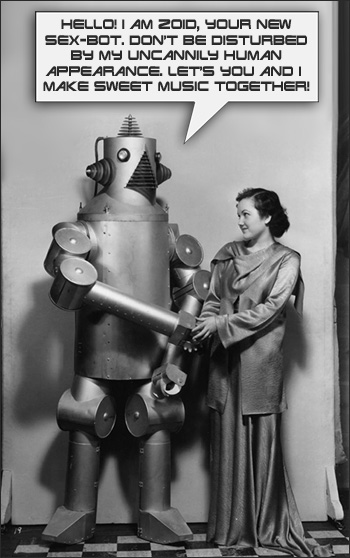
I’ve been reading a lot of stuff lately about people (mainly Japanese people, it has to be said) extolling the virtues of the imminent Robot Revolution. I’m sure you all saw scientists at Tokyo’s Waseda University recently wheeling out their Twendy-one, a kind of home-help robot designed for aged-care, and last year Hiroshi Ishiguro of Osaka University was appearing all over the media with his ‘actroids’, including the odd ventriloquist-doll-like ReplieeQ1 who is variously described as ‘scarily realistic’ and ‘scarily life-like’ but seems to me just plain ‘scarily scary‘.*
I’m not too impressed about the idea of robots getting to be all pally with us, despite the enthusiasm coming out of Nippon. As much as I really loved the concept of our funky metal friends when I was a kid watching The Jetsons and Lost in Space, I’ve seen the future of robotic intrusion into our lives, and I just know that if our destiny is going to involve robots, I’m much more likely to be teaming up with Magnus, Robot Fighter than with little Jimmy Sparks.
I am, of course, extrapolating from the way robots currently ‘help’ us with our affairs. I’m sure you’ve tangled with the ‘proto-bots’ too, but let me elaborate.
Telstra, Australia’s biggest telco, has had in operation for a while now for our convenience, a voice-recognition fembot to handle incoming calls. I often find myself having to call Telstra and I have come to dread the experience. This is how my conversation with this artificial ‘intelligence’ typically proceeds (try to imagine a sing-songy overly-chummy female voice for the fembot):
Fembot: Welcome to Telstra. So that I can direct your call to the right place, in just a few words please tell me the reason for your call.
Me: Incorrect charges on my bill.
Fembot: That would be about a single bill? Does that sound OK?
Me: What? A single bill? What does that mean?
Fembot: I’m sorry, I didn’t quite get that. Let’s try again. In just a few words, tell me the reason for your call.
Me: You’ve charged me for calls I didn’t make. Again.
Fembot: I think there could be faults or problems with your phone, does that sound OK?
Me: No!
Fembot: And is that for a mobile?
Me: What? No. It’s not a mobile.
Fembot: Can you give me the number of the mobile?
Me: It’s not a mobile!
Fembot: And what number would that mobile be?
Me (grrr): I want to talk to an operator.
Fembot: So that I can direct your call, please tell me in a few words the reason for your call.
Me: Aaaaargh! Operator. Operator. Give me a human. Operator. Operator. Operator.
Fembot: OK, please wait and I’ll get a customer service representative.
When the human comes online, we are invariably able to sort the problem out in seconds.
How many things do I resent about talking to the fembot? For a start, I despise the way it assumes a cloak of intelligence and power right from the get-go. By giving the impression that it has some kind of control over what it offers to be able to do for me, it looks all the more moronic for not being able to understand the most basic of syntax; I am phoning to try and sort out a problem and find that I’m immediately talking to an IDIOT. Let me ask you: if you were setting up a business, how likely is it that you go out and hire the stupidest person you could find, and then put them on the switchboard? Well, it’s worse than that.
Next, I loathe the maladroit attempt by the programmers to make the fembot appear chummy. Gone is the stilted computer formant voice of yesterday, replaced now with a studied, efficient-but-friendly, carefully modulated, fluid female phrasing that manages to come across as simultaneously condescending and obsequious. The sing-song inflections are reminiscent of the way someone might speak to a very young child, and the colloquial tone (Does that sound OK?) is merely grating and infuriating when intoned by a gadget whose nearest relative is a talking clock. At least when you got the phoneme-retarded cut-up voices of the past you were comprehensively aware that it was a clunky computer trick that you were dealing with.
But most of all I am maddened by the fact that every time I call I am completely unable to resist being drawn into talking to the damn thing as if it was an actual person, and wasting a good minute or so getting exactly to where I should have been at ‘Hello’.
The technicians who build these machines have got it in their heads that if they make them more people-like, we will accept them more easily, but for me, at least, the closer these things come to having the semblance of humanness, the greater is my desire to punch them. And, in contrast to the way I might deal with a real human idiot, there’s really no moral reason to curb that inclination.
This is what I fear about the coming of the real Robots. At least when the android is separated from me by a phone line, the most I can do is yell at the damn thing (which, I might add, I have done on numerous occasions).†But if Robo was in arm’s reach, then I swear, the word robocide will enter the lexicon faster than you can say klaatu barada nikto. This of course would necessitate the invention of laws. Not as Mr Asimov supposed, Three Laws designed to stop robots from harming humans, but instead, a single Law to stop humans turning robots into boat anchors.
This explains, at least, why they’re practising with robots in aged care: lowered retaliation factor. Better to send the droids up against feeble old folks than aspiring Magnuses.
It’s obvious though, that the boffins, as much as they might know all the ins & outs of their mechanical friends, don’t have even the vaguest concept about aged care. I’m just itching to watch the first practical tests when they send ReplieeQ17 in to deal with some old codger with dementia. I expect it to go something like this:
RQ17: Hello Mr ÄŒapek. I am here to prepare your breakfast. In just a few words, tell me what you would like?
Old Codger: You say what, young fella?
RQ17: I’m sorry I missed that, let’s try it again. Can you tell me, in just a few words, what you would like for breakfast?
Old Codger: Breakfast? Breakfast? What happened to lunch?
RQ17: Would that be oatmeal and fruit? Does that sound OK?
Old Codger (hits robot with cane): Are you trying to steal my money?!
RQ17: Did you say “my money is missing”?
Old Codger: YOU STOLE MY MONEY!
RQ17: I’m sorry, I didn’t catch that. Would you like to report a robbery? Does that sound right?
Old Codger: There’s something wrong with your face. Are you a Chinaman? Where’s my breakfast anyway?
RQ17: In just a few words, tell me what you would like for breakfast and I will prepare it for you.
Old Codger: A Chinaman stole my money! I knew it!
Well, you get the drift.
Personally, when all’s said and done, if it really is necessary to have a Robot Revolution, I want my robots to look and act like robots. If there’s a problem, I don’t need some kind of creepy pseudo-human standing there and negotiating with me. I just want a big clunky tin can filled with flashing lights, wobbling the claws on the end of its vacuum-cleaner arms, and blurting out in a grating metallic voice:‘Warning! Warning Will Robinson!’
___________________________________________________________________________
*Hiroshi Ishiguro has also created Geminoid HI-1, a robot that looks exactly like himself. Well, exactly like himself if he was a spastically jerking animatronic life-size doll.
†I’m not alone in this it would seem. Current research into voice recognition systems for handling telephone enquiry lines is examining ways to extract ’emotional’ tones from callers’ voices in an effort to recognize unhappy campers. Presumably these callers are then somehow dealt with differently to people stupid patient enough to play footsie with the robots.
A special thanks to Pete at Headless Hollow for the Magnus scan. I grew up reading Magnus comics and I really loved the wacky robots-gone-amok future that they suggested.
___________________________________________________________________________









